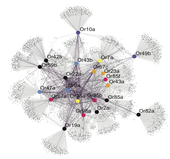Highlight
Predicting what smells: A systems level analysis of odor receptors
Achievement/Results
A NSF ChemGen Interdisciplinary Graduate Education, Research and Training (IGERT)-sponsored study at the University of California Riverside focuses on understanding the exquisite sense of smell of insects and other animals. ChemGen IGERT trainee Sean Boyle, supervised by Assistant Professor Anandasankar Ray, aims to predict the molecules that the hundreds of different odor receptors (Or) of animals can bind to trigger the perception of smell.
Little is know about how odor receptors detect a wide variety of volatile chemicals with high degrees of specificity and sensitivity. Boyle performed a systems level analysis of odor coding by predicting what odors can be recognized by Ors expressed in the Drosophila antenna. He identified ~150 novel Or activators and predicted hundreds more for each receptor. Screening large numbers of activators enabled the identification of a novel class of odors that activate Ors for an extended period of time. These “prolonged activating” odors disrupt the receptors and thus the insect’s ability to detect the other odors it comes in contact with after the initial prolonged activating odor exposure. The identification of “prolonged activating” odors – a new class of odors – could have major implications for behavior modification of pest and disease vector species.
Address Goals
Our research focuses on predicting receptor-odor interactions with high accuracy, allowing us to both better understand how organisms understand their complex odor environment and to screen for odors with interesting behavior modifying properties. We validate our predictions using single unit electrophysiology followed by focused behavioral assays. Identified odors can potentially be used to modify the behavior of both pest and disease vector species, which cause billions of dollars of agricultural losses and millions of deaths per year.






